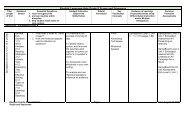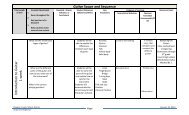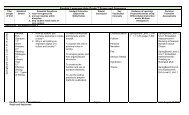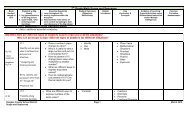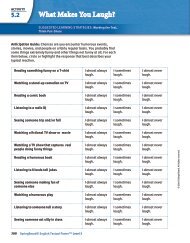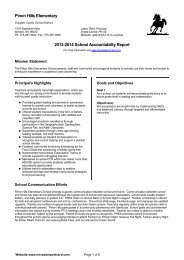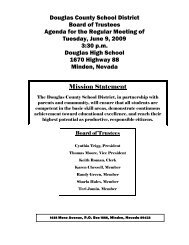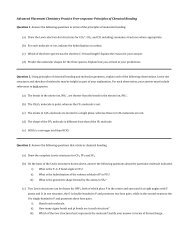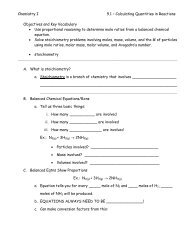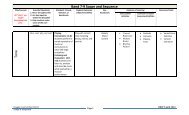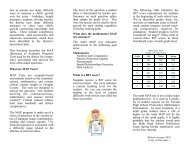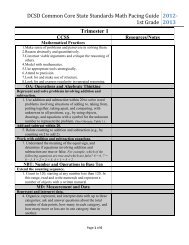SCIENCE COMPETENCY CURRICULUM GUIDE
SCIENCE COMPETENCY CURRICULUM GUIDE
SCIENCE COMPETENCY CURRICULUM GUIDE
You also want an ePaper? Increase the reach of your titles
YUMPU automatically turns print PDFs into web optimized ePapers that Google loves.
<strong>SCIENCE</strong> <strong>COMPETENCY</strong> <strong>CURRICULUM</strong> <strong>GUIDE</strong><br />
Exit Competency D: Students will demonstrate competency in understanding basic principles and theories of earth science whether from geology,<br />
astronomy, meteorology, oceanography, including: 2. Distribution of ecosystems on the earth s surface, including the local environment<br />
Objectives: Assessment: Possible Resources: Possible Strategies:<br />
By the end of 3 rd grade, students will:<br />
1. Understand the three physical<br />
characteristics of the Earth as:<br />
-a sphere<br />
-made up of water<br />
-made up of land<br />
by identifying all on a threedimensional<br />
model.<br />
Time:<br />
2 nd 1 hour. Review throughout<br />
the year<br />
3 rd One class period (45<br />
minutes).<br />
May 29, 2001<br />
1<br />
1. Provided Instructional Resources:<br />
Air kit, DCSD, 1 st grade<br />
Astronomy kit, DCSD, 3 rd grade<br />
Globe/maps<br />
Investigating Liquids kit, DCSD<br />
2 nd grade<br />
Weather unit, DCSD, 3 rd grade<br />
Supplementary Resources:<br />
Beginning Geography, Evan<br />
Moor Corp.<br />
Geo-globe<br />
Graphs - Steck-Vaughn<br />
Mega-Fun Map Skills, Tamblyn,<br />
C., Scholastic Books, 1998<br />
Paper mache<br />
Pictures from books and<br />
magazines on natural and<br />
manmade objects<br />
Success with Maps, Scholastic<br />
Skills<br />
Teacher worksheets<br />
Resource available at D. O.<br />
Curriculum Office<br />
What are the Other Kids Doing?<br />
Marriott, D., Creative Teaching<br />
Press, 1997<br />
World Rap<br />
Resource available at D.O.<br />
Curriculum Office<br />
1. Instructional strategies could<br />
include:
<strong>SCIENCE</strong> <strong>COMPETENCY</strong> <strong>CURRICULUM</strong> <strong>GUIDE</strong><br />
Exit Competency D: Students will demonstrate competency in understanding basic principles and theories of earth science whether from geology,<br />
astronomy, meteorology, oceanography, including: 2. Distribution of ecosystems on the earth s surface, including the local environment<br />
Objectives: Assessment: Possible Resources: Possible Strategies:<br />
2. Understand basic weather<br />
concepts, including:<br />
-precipitation - water falls to<br />
the earth as rain, snow<br />
and other forms<br />
-temperature - the sun<br />
provides light and heat<br />
for weather<br />
-wind - air move<br />
by creating a verbal, written,<br />
visual or physical representation<br />
showing all three.<br />
Time:<br />
1 st 3-4 weeks<br />
2 nd Once a week<br />
3 rd Approx.7- 8 weeks. Four 40<br />
minute periods each week.<br />
May 29, 2001<br />
2<br />
2. Provided Instructional Resources:<br />
Air kit, DCSD, 1 st grade<br />
Investigating Liquids, DCSD, 2 nd<br />
grade<br />
Library materials<br />
Weather, DCSD, 3 rd grade<br />
Supplementary Resources:<br />
AIMS activities/science books<br />
Cloudy with a Chance of<br />
Meatballs, by J. Barrett<br />
Departmental teachers<br />
Eyewitness weather videos<br />
Hurricane, by D. Wiesner<br />
It Looked Like Spilt Milk, by C.<br />
Shaw<br />
Magic School Bus Inside A<br />
Hurricane<br />
Magic School Bus Kicks Up a<br />
Storm<br />
Meteorologist as guest speaker<br />
Nevada Appeal<br />
Now I know What Makes the<br />
Weather, Palazzo, J., Troll, 1982<br />
Science books<br />
Science Fair Projects by Daryl<br />
Vriesenta; Instructional Fair,<br />
Inc., (water)<br />
Songs and songbooks that<br />
contain objectives<br />
The Music Book<br />
Thematic Units:<br />
. Weather unit, grades 2-3,<br />
Instructional Fair #IF8827<br />
. Weather by D. Williams,<br />
1991, Teacher Created<br />
2. Instructional strategies could<br />
include:<br />
Plan a wardrobe appropr iate for<br />
weather<br />
Predict if dog s H20 will freeze
<strong>SCIENCE</strong> <strong>COMPETENCY</strong> <strong>CURRICULUM</strong> <strong>GUIDE</strong><br />
Exit Competency D: Students will demonstrate competency in understanding basic principles and theories of earth science whether from geology,<br />
astronomy, meteorology, oceanography, including: 2. Distribution of ecosystems on the earth s surface, including the local environment<br />
Objectives: Assessment: Possible Resources: Possible Strategies:<br />
3. Demonstr ate th at water can be<br />
liquid or solid, that it can be<br />
made to go back and forth from<br />
one form to another, and that the<br />
amount of water stays the same<br />
by creating a verbal, written,<br />
visual or physical representation<br />
of the sequence of events and<br />
possible causes of change.<br />
Time: 3 days 1 week<br />
May 29, 2001<br />
3<br />
Materials<br />
. Weather and Climate,<br />
Carson Pellosa, #CD 7278<br />
Tornado, by B. Byars<br />
Water Cycle Kit from UNR<br />
Water Precious Water, AIMS<br />
Activities, A Collection of<br />
Elementary Water Activities,<br />
grades 2-6, 1988 AIMS<br />
Education Foundation<br />
Weather books<br />
Weather Rap, by Emerson<br />
Weather Words, by G. Gibbon<br />
Weekly Readers/posters<br />
What Will the Weath er Be?<br />
DeWitt, L., Harper Collins, NY,<br />
1991<br />
3. Provided Instructional Resources:<br />
Liquids kit, DCSD, 2 nd grade,<br />
lesson #9<br />
Investigating Hard Water kit,<br />
DCSD,<br />
Weather kit, DCSD, 3 rd grade<br />
Supplementary Resources:<br />
H2 0 water cycle poster<br />
Project wet activities<br />
Science lesson in classroom<br />
Water Precious Water, AIMS<br />
activities<br />
3. Instructional strategies could<br />
include:<br />
Draw H 20 cycle at home/school
<strong>SCIENCE</strong> <strong>COMPETENCY</strong> <strong>CURRICULUM</strong> <strong>GUIDE</strong><br />
Exit Competency D: Students will demonstrate competency in understanding basic principles and theories of earth science whether from geology,<br />
astronomy, meteorology, oceanography, including: 2. Distribution of ecosystems on the earth s surface, including the local environment<br />
Objectives: Assessment: Possible Resources: Possible Strategies:<br />
By the end of 6 th grade, students will:<br />
1. Know that an ecosystem is an<br />
interdependency of living and<br />
nonliving things by describing a<br />
complete ecosystem, consisting<br />
of at least the elemen ts of:<br />
-sun<br />
-soil<br />
-water<br />
-air<br />
-plants<br />
-animals<br />
through a verbal, written, visual<br />
or physical representation.<br />
(See also Competency B4.)<br />
Time:<br />
3-4 1 month per ecosystem<br />
4 th 1 hour per lesson in Isopod<br />
kit (12 lessons)<br />
2. Understand that water moves<br />
through three stages in the water<br />
cycle:<br />
-evaporates from the surface<br />
of the earth, rises, and<br />
cools<br />
-condenses as rain or snow<br />
-falls to the surface as<br />
precipitation<br />
by drawing or explaining the<br />
stages of a water cycle, using the<br />
terminology: evaporation,<br />
condensation and precipitation.<br />
Time: 2 hours/ quick review<br />
May 29, 2001<br />
4<br />
1. Provided Instructional Resources:<br />
Isopods, DCSD science kit, 4 th<br />
grade<br />
Supplementary Resources:<br />
Interact Company: Paul s Pond,<br />
Debbie s Desert<br />
Naturescope (Rainforest, Trees,<br />
trees, trees, ocean (JVES)<br />
Ranger Rick magazine<br />
Student worksheets<br />
2. Provided Instructional Resources<br />
Voyage of the Mimi I, DCSD, 6 th<br />
grade<br />
Supplementary Resources:<br />
Handout - Stages of H2O Cycle<br />
Information on Nevada Water<br />
Calendars<br />
The Magic Bus, Water Cycle<br />
Video - Bill Nye the Science<br />
Guy<br />
Weather brochures from DRI in<br />
Reno<br />
1. Instructional strategies could<br />
include:<br />
Students could design a jigsaw<br />
representation of an ecosystem,<br />
showing the dependence of each<br />
piece on the others.<br />
2. Instructional strategies could<br />
include:<br />
Students could be given an<br />
ecosystem or an element of the<br />
ecosystem.
<strong>SCIENCE</strong> <strong>COMPETENCY</strong> <strong>CURRICULUM</strong> <strong>GUIDE</strong><br />
Exit Competency D: Students will demonstrate competency in understanding basic principles and theories of earth science whether from geology,<br />
astronomy, meteorology, oceanography, including: 2. Distribution of ecosystems on the earth s surface, including the local environment<br />
Objectives: Assessment: Possible Resources: Possible Strategies:<br />
3. Understand that there are a<br />
variety of climate zones on the<br />
earth, including, but not limited<br />
to:<br />
-desert<br />
-mountain<br />
-tropical<br />
-polar<br />
-forest<br />
by drawing, modeling or writing<br />
a description of at least four<br />
climate zones and comparing/<br />
contrasting two.<br />
Time: One week project<br />
2-4 hours<br />
4. Know that geology and climate<br />
are physical characteristics that<br />
determine the environment of an<br />
ecosystem by explaining their<br />
impact on a given environment.<br />
(See Social Studies Competency<br />
A1 for geography: land forms;<br />
oceans, lakes, rivers)<br />
Time:<br />
May 29, 2001<br />
5<br />
3. Provided Instructional Resources:<br />
Atlas<br />
Geography textbook and kit<br />
History books<br />
Voyage of the Mimi I, DCSD, 6 th<br />
grade<br />
Supplementary Resources:<br />
Climate/geographical feature<br />
chart<br />
Coloring materials<br />
Large white paper<br />
Teacher-made materials<br />
Who s Home in the Biome, in<br />
AIMS Critters<br />
4. Provided Instructional Resources:<br />
Supplementary Resources:<br />
Books sea to mountain themes<br />
Geography book<br />
3. Instructional strategies could<br />
include:<br />
Students could give an<br />
explanation of personal<br />
preference as a way of<br />
comparing/ contrasting.<br />
4. Instructional strategies could<br />
include:<br />
ex: Why is the Great Basin a<br />
desert?



